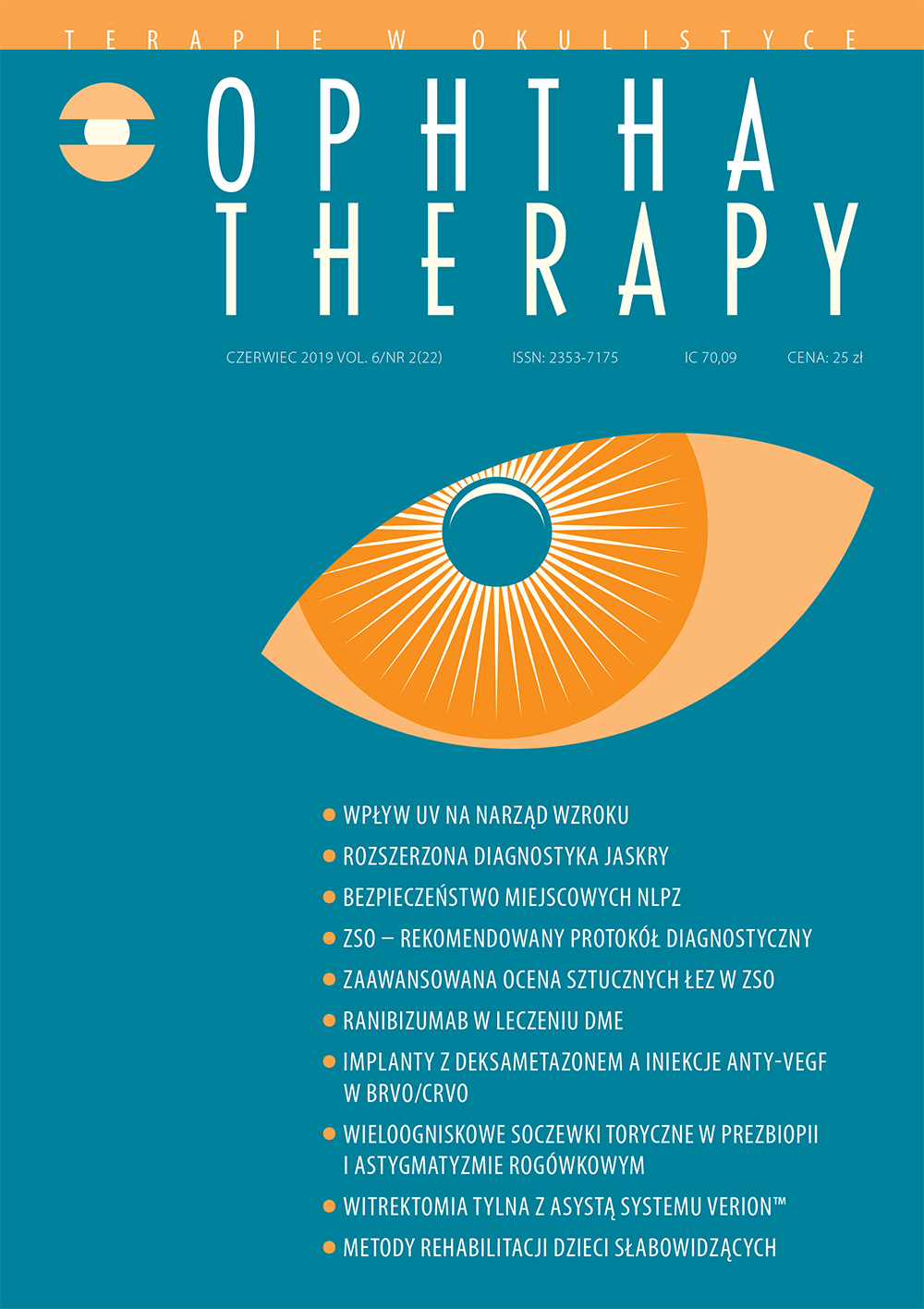Rehabilitation of visually impaired children – methods and their effectiveness
Main Article Content
Abstract
Vision impairment in childhood often has an impact on whole life. Low vision children and their parents face enormous challenges related to general development and independence. Activities aimed at the highest possible level of functioning and participation in society provide these children with a high quality of life, and to achieve this, children should have the right to the most effective rehabilitation programs. The study presents an analysis of the effectiveness of rehabilitation interventions in visually impaired children, which lead to improvement of their skills and quality of life. The results suggest that sports camps, aids for the visually impaired and training in their use, and oral hygiene programs can effectively improve the functioning and participation and quality of life of visually impaired children. Due to the rapid development of new technologies, the small size of the study groups and the small number of high-quality studies, the results should be interpreted with caution, and future research should focus on therapies where efficacy is still unclear.
Downloads
Article Details

This work is licensed under a Creative Commons Attribution-NonCommercial-NoDerivatives 4.0 International License.
Copyright: © Medical Education sp. z o.o. License allowing third parties to copy and redistribute the material in any medium or format and to remix, transform, and build upon the material, provided the original work is properly cited and states its license.
Address reprint requests to: Medical Education, Marcin Kuźma (marcin.kuzma@mededu.pl)
References
2. WHO: Global data on visual impairments 2010. Geneva, Switzerland, 2012. https://www.who.int/blindness/GLOBALDATAFINALforweb.pdf .
3. Wrzesińska M, Kapias J, Nowakowska-Domagała K et al. Niepełnosprawność wzrokowa a obecność cech autystycznych u dzieci. Psychiatria Polska. 2017; 51(2): 349-358. https://doi.org/ 10.12740/PP/OnlineFirst/61352.
4. Açıl D, Ayaz S. Screening of Visually Impaired Children for Health Problems. Asian Nursing Research. 2015; 9(4): 285-90.
5. WHO: Blindness and vision impairment. 11 October 2018. https://www.who.int/news-room/fact-sheets/detail/blindness-and-visual-impairment .
6. WHO: The International Classification of Functioning, Disability and Health for Children and Youth (ICF-CY). Geneva, World Health Organization, 2007.
7. Heerkens Y, Hendriks E, Oostendorp R. Assessment instruments and the ICF in rehabilitation and physiotherapy. Medical Rehabilitation. 2006; 10(3): 1-14.
8. Międzynarodowa Klasyfikacja Funkcjonowania Niepełnosprawności i Zdrowia (ICF). https://www.csioz.gov.pl/fileadmin/user_upload/Wytyczne/statystyka/icf_polish_version_56a8f7984213a.pdf .
9. Corn AL, Wall RS, Jose RT et al. An initial study of reading and comprehension rates for students who received optical devices. J Vis Impair Blind. 2002; 96(5): 322-34.
10. Elsman EB, Al Baaj M, van Rens GH et al. Interventions to improve functioning, participation and quality of life in children with visual impairment: a systematic review. Surv Ophthalmol. 2019. https://doi.org/ 10.1016/j.survophthal.2019.01.010.
11. Kumar S, Konde S, Raj S, Agarwal M. Effect of oral health education and fluoridated dentifrices on the oral health status of visually impaired children. Contemp Clin Dent. 2012; 3(4): 398-401. https://doi.org/10.4103/0976-237X.107425.
12. Chowdary PB, Uloopi K, Vinay C et al. Impact of verbal, braille text, and tactile oral hygiene awareness instructions on oral health status of visually impaired children. J Indian Soc Pedod Prev Dent. 2016; 34(1): 43
13. Aki E, Atasavun S. Training motor skills of children with low vision. Perceptual and Motor Skills. 2007; 104(3): 1328-36.
14. Platje E, Sterkenburg P, Overbeek M et al. The efficacy of VIPP-V parenting training for parents of young children with a visual or visual-and-intellectual disability: a randomized controlled trial. Attach Hum Dev. 2018: 1-18.
15. Mc Mahon JM. Measures of self-perception, level of physical activity, and body mass index of participants of sports education camps for youth with visual impairments: Impact of participating in a short-term intervention model of sports education camps for children with visual impairments, Western Michigan University, 2013.
16. Rose D. Braille is spreading but who’s using it? BBC News 2012. https://www.bbc.com/news/magazine-16984742#TWEET77195.
17. Toussaint KA, Tiger JH. Teaching early braille literacy skills within a stimulus equivalence paradigm to children with degenerative visual impairments. J Appl Behav Anal. 2010; 43(2): 181-194. https://doi.org/ 10.1901/jaba.2010.43-181.
18. Augestad LB, Klingenberg O, Fosse P. Braille use among Norwegian children from 1967 to 2007: trends in the underlying causes. Acta Ophthalmol. 2012; 90(5): 428-34.
19. Gothwal VK, Sumalini R, Bharani S. Assessing the Effectiveness of Low Vision Rehabilitation in Children: An Observational Study. Invest Ophthalmol Vis Sci. 2015; 56(5): 33553360.
20. Nyquist JB, Lappin JS, Zhang R, Tadin D. Perceptual training yields rapid improvements in visually impaired youth. Sci Rep. 2016; 6.
21. Corn AL, Wall RS, Jose RT et al. An initial study of reading and comprehension rates for students who received optical devices. J Vis Impair Blind. 2002; 96(5): 322-334.
22. Bogdănici CM, Săndulache CM, Martinescu G et al. Can patients with visual impairment follow a normal school? Rom J Ophthalmol. 2016; 60(2): 103-8.
23. Negiloni K, Ramani KK, Jeevitha R et al. Are children with low vision adapted to the visual environment in classrooms of mainstream schools? Indian J Ophthalmol. 2018; 66(2): 285-9.
24. Vincent SJ. The use of contact lenses in low vision rehabilitation: optical and therapeutic applications. Clin Exp Optom. 2017; 100(5): 513-21.

